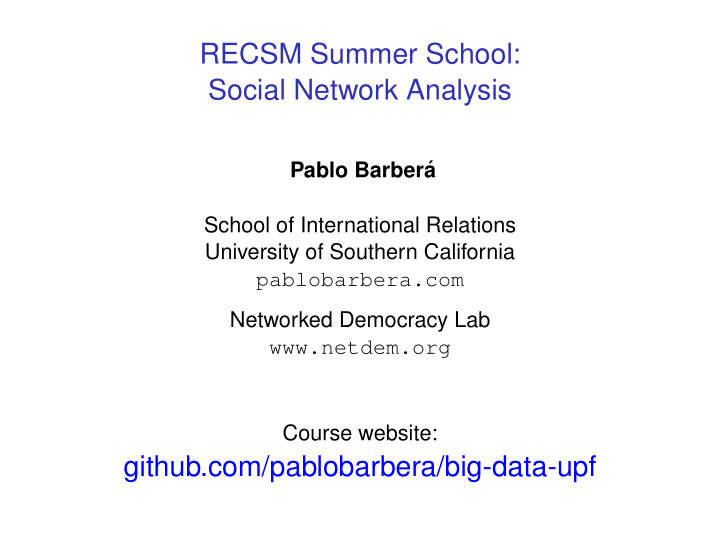



RECSM Summer School: Social Network Analysis Pablo Barber´ a School of International Relations University of Southern California pablobarbera.com Networked Democracy Lab www.netdem.org Course website: github.com/pablobarbera/big-data-upf
Moreno, “Who Shall Survive?” (1934)
Moreno, “Who Shall Survive?” (1934)
Moreno, “Who Shall Survive?” (1934)
Moreno, “Who Shall Survive?” (1934)
Christakis & Fowler, NEJM, 2007
Adamic & Glance, 2004, IWLD
Email network of a company
Barbera et al, 2015, Psychological Science
Social Network Analysis Today: ◮ Basic concepts ◮ Importing network data into R ◮ Network visualization ◮ Node and network-level summary statistics ◮ Community detection ◮ Network decomposition techniques Beyond the scope of this course (but ask me!) ◮ Modeling network properties: Exponential random graph models ◮ Large-scale network visualization with Gephi ◮ Bipartite/Multiplex networks
Basic concepts ◮ Node (vertex): each of the units in the network
Basic concepts ◮ Node (vertex): each of the units in the network ◮ Edge (tie): connection between nodes
Basic concepts ◮ Node (vertex): each of the units in the network ◮ Edge (tie): connection between nodes ◮ Undirected: symmetric connection, represented by lines
Basic concepts ◮ Node (vertex): each of the units in the network ◮ Edge (tie): connection between nodes ◮ Undirected: symmetric connection, represented by lines ◮ Directed: imply direction, represented by arrows
Basic concepts ◮ Node (vertex): each of the units in the network ◮ Edge (tie): connection between nodes ◮ Undirected: symmetric connection, represented by lines ◮ Directed: imply direction, represented by arrows ◮ A network consists of a set of nodes and edges
Basic concepts A few examples: ◮ Classroom: students / friendships
Basic concepts A few examples: ◮ Classroom: students / friendships ◮ Twitter: users / retweets
Basic concepts A few examples: ◮ Classroom: students / friendships ◮ Twitter: users / retweets ◮ Academic literature: papers / citations
Basic concepts A few examples: ◮ Classroom: students / friendships ◮ Twitter: users / retweets ◮ Academic literature: papers / citations ◮ Internet: websites / hyperlinks
Basic concepts A few examples: ◮ Classroom: students / friendships ◮ Twitter: users / retweets ◮ Academic literature: papers / citations ◮ Internet: websites / hyperlinks ◮ Trade: countries / trade flows
Basic concepts A few examples: ◮ Classroom: students / friendships ◮ Twitter: users / retweets ◮ Academic literature: papers / citations ◮ Internet: websites / hyperlinks ◮ Trade: countries / trade flows ◮ Biology: neurons / connections
Basic concepts Network Visualization Adjacency Matrix J J E W T Tom J 0 1 1 0 0 Josh J 1 0 0 1 1 E 1 0 0 1 0 W 0 1 1 0 1 Whitney Jennifer T 0 1 0 1 0 Evgeniia
Basic concepts Network Visualization Edgelist Node1 Node2 Tom 1 Jennifer Josh Josh 2 Jennifer Evgeniia 3 Josh Whitney 4 Josh Tom Whitney Jennifer 5 Whitney Tom 6 Evgeniia Whitney Evgeniia
Recommend
More recommend